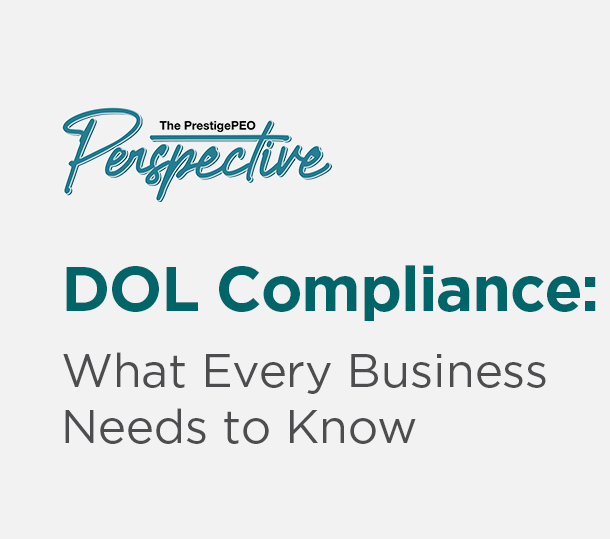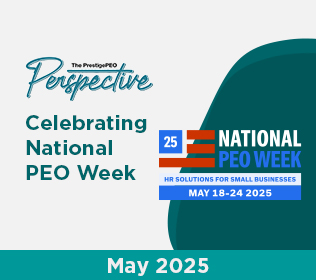Understanding DOL Compliance for Growing Businesses
Navigating U.S. Department of Labor (DOL) regulations can be challenging for small and medium-sized businesses (SMBs), especially as rules evolve and enforcement increases.
Our latest article breaks down the core areas the DOL oversees and explains how PrestigePEO helps SMBs stay compliant, avoid costly penalties, and operate with confidence.

Is a MEC Plan Right for Your Business?
Comparing MEC to Traditional Benefits: Make the Right Call
In this article, we walk you through what MEC plans include (and exclude), when they can work, and when broader coverage is required.
With PrestigePEO acting as your strategic advisor, you can make informed decisions for your business, mitigate risk, improve benefits, and stay compliant.

ADA Compliance in Action
Practical Strategies for Today’s Workplace
If you missed our recent ADA Compliance webinar, you can now access the full recording on demand. In this session, our compliance and HR experts broke down the essentials every employer needs to reduce risk and protect their workforce, including the ADA interactive process, leave coordination across FMLA and workers’ compensation, and key regulatory trends.
Watch now to gain clear, practical guidance you can apply immediately to strengthen compliance and support your employees with confidence.

CA Law Changes Employers Should Prepare For in 2026
California Employment Law Updates for 2026
This year, California’s Governor Newsom signed several new bills aimed at expanding California worker protections, resulting in increased employer obligations. Highlighted below are the changes employers will need to review and plan to update their policies accordingly, with many of these new laws taking effect January 1, 2026.
Personnel Records to Include Education or Training Records
Effective January 1, 2026, SB 513 amends the Labor Code to require employers to provide employees with access to their education or training records, in addition to existing personnel records. These records must include: (1) employee name; (2) training provider; (3) training date and duration; (4) core competencies, including equipment or software skills; and (5) certification or qualification earned. All other requirements remain, such as making records available within 30 days of a written request and suspending the right to inspect during related lawsuits against the employer or former employer.
WARN Notice Revisions
Effective January 1, 2026, SB 617 amends the written notice requirement provided for a mass layoff, relocation, or termination pursuant to the California Worker Adjustment and Retraining Act to include: (1) information on whether the employer plans to coordinate rapid response services through the local workforce development board or another entity, along with a specific contact information; (2) information regarding CalFresh, the statewide food assistance program; (3) standardized job placement/retraining language; and (4) employer contact details.
Stay-or-Pay Employment Contract Repayment Requirements Unlawful
AB 692 adds limitations to the Business and Professions Code and will apply to all employers and all employment contracts entered into, on, or after January 1, 2026, prohibiting the inclusion of any term or conditions of the employment contract that require a worker to pay an employer, training provider, or debt collector for a debt or repay fees or costs incurred by an employers on the employee’s behalf should the worker’s employment or work relationship with a specific employer terminates. Narrow exceptions related to tuition repayment, bonuses, apprenticeship programs, and others exist, but employers are encouraged to fully understand these exceptions and all associated penalties for non-compliance. Violations of Section 16608 are considered void as contrary to public policy.
Penalties for non-compliance include the right for any worker subjected to such a contract or contract term to bring a private civil cause of action on behalf of that worker, or other persons similarly situated, to court. Employer may be liable for actual damages sustained by the worker or workers on whose behalf the case is brought, or five thousand dollars ($5,000) per worker, whichever is greater, as well as injunctive relief, and reasonable attorney’s fees and costs
Pay Equity and Data Reporting
Equal Pay Act Amendments
Effective January 1, 2026, Section 432 of the Labor Code changes the term “pay scale” in job posting requirements to a “good faith estimate of the salary or hourly wage range that the employer reasonably expects to pay for the position upon hire.” The bill also revises Section 1197.5 of the Labor Code, which prohibits employers from paying employees at wage rates lower than those paid to employees of another sex for substantially similar work, subject to certain exceptions. SB 642 replaces “opposite” with “another” sex and defines “wages” and “wage rates” to include various forms of pay, such as salary, overtime pay, bonuses, stock options, profit sharing and bonus plans, life insurance, vacation and holiday pay, cleaning or gasoline allowances, hotel accommodations, reimbursement for travel expenses, and benefits. The bill also enlarges the statute of limitations from two to three years for pay equity claims and provides for the recovery of lost wages during the entire duration of the violation, up to six years.
Employee Pay Data Reporting Expanded
Under existing law, private employers with 100 or more employees are required to submit annual pay data reporting to the Civil Rights Department (CRD). This report must detail the number of employees by race, ethnicity, and sex across ten specified job categories, indicate the distribution of employees by these demographics within federal pay bands, provide the median and mean hourly rates for each group within every job category, and record the total number of hours worked by each employee reported in each pay band. The submission deadline for this report is the second Wednesday in May each year, which for the upcoming cycle falls on May 13, 2026.
With the enactment of SB 464, California has enhanced its employer obligations concerning pay data reporting. The new legislation introduces several significant updates: (1) demographic information collected must now be gathered and stored separately from employees’ personnel records; (2) the statutory language regarding civil penalties has been revised to state that courts “shall” impose a civil penalty of up to $100 per employee for noncompliance and $200 per employee for subsequent violations at the request of the CRD, replacing the previous discretionary “may”; and (3) effective January 1, 2027, the scope of job categories requiring reporting will expand from ten to twenty-three.
Expanded PFL Benefits to Include Care for Designated Person
Beginning July 1, 2028, California’s Paid Family Leave (PFL) will expand coverage to employees who take time off to care for a seriously ill “designated person,” defined as someone related by blood or with a family-like relationship, as well as a family member. Employees must identify this person when applying for benefits and confirm the relationship under penalty of perjury.
Further Revisions to Victim Protections
AB 2499 updates California’s victim-of-violence workplace protection laws under the California Fair Employment and Housing Act (FEHA) to cover family members of victims and allow paid sick leave for qualifying violence-related reasons, effective immediately.
Penalties for Unpaid Wage Judgments
Additions to the Labor Code under SB 261 state that if a final judgment resulting from nonpayment of wages for work performed in California remains unsatisfied for 180 days after the appeal period has ended and no appeal is pending, the judgment debtor may be subject to a civil penalty of up to three times the outstanding judgment amount, including post-judgment interest. The court is required to assess the full penalty unless it determines, based on clear and convincing evidence, that there is good cause to reduce the penalty amount. Penalties are distributed equally between the employee(s) benefiting from the judgment and the DLSE.
Additionally, SB 261 grants the prevailing plaintiff reasonable attorney’s fees and costs in any action brought by a judgment creditor, the Labor Commissioner, or a public prosecutor to enforce a final judgment related to unpaid wages, penalties, or other amounts owed for work performed in California, or to encourage compliance or impose lawful consequences on a judgment debtor who has not satisfied such a judgment.
Labor Commissioner to Enforce Gratuity Law Violations
The Labor Code currently states that “[n]o employer or agent shall collect, take, or receive any gratuity or a part thereof that is paid, given to, or left for an employee by a patron, or deduct any amount from wages due an employee on account of a gratuity, or require an employee to credit the amount, or any part thereof, of a gratuity against and as a part of the wages due the employee from the employer.” SB 648 amends this portion of the Labor Code to allow the Labor Commissioner to investigate and issue a citation or file a civil action “for gratuities taken or withheld in violation of this section.”
Expansion of PERB to Private Sector Workers
Effective January 1, 2026, AB 288 addresses the limitations of the current National Labor Relations Board (NLRB) by expanding the California Public Employment Relations Board’s (PERB) authority to process representation petitions and unfair labor practice cases. Workers may petition PERB if their position loses coverage under the National Labor Relations Act (NLRA) due to changes in the Act or if the NLRB “expressly or impliedly ceded jurisdiction,” such as by delaying a case for over 12 months. The bill also allows the California Agricultural Labor Relations Board (ALRB) to treat NLRA precedents as persuasive but not binding. On October 15, 2025, the NLRB sued California and PERB, claiming AB 288’s jurisdictional expansion is preempted by the NLRA. (National Labor Relations Board v. State of California, E.D. Cal. Case No. 2:25-at-01400).
Transportation Network Company Drivers Labor Relations Act
Effective January 1, 2026, the Transportation Network Company Drivers Labor Relations Act grants TNC drivers the right to form, join, organize, and participate in driver organizations, bargain collectively, engage in concerted activities for mutual benefit, or abstain from such actions. A “TNC driver” is anyone using their personal vehicle with a TNC’s app or platform to transport passengers in California, while a “TNC” refers to an entity that offers paid, prearranged transportation via an online-enabled platform per the Public Utilities Code. The law also requires TNCs to submit quarterly reports to PERB and establishes procedures for certifying and decertifying driver organizations, among other provisions. TNCs will also be required to negotiate in good faith with certified driver bargaining organizations and provide notices to TNC drivers about union organization and representation.
Transparency in Frontier Artificial Intelligence Act
Effective September 29, 2025, the Transparency in Frontier Artificial Intelligence Act (TFAIA), sets transparency and reporting rules for frontier developers. It prohibits policies that block or punish employees from reporting risks or violations, offers whistleblower protections, and requires large developers to provide an anonymous internal reporting process.
Bias Mitigation Training Does Not Constitute Discrimination
California has passed legislation, effective January 1, 2025, that encourages employers to provide bias mitigation training by clarifying that if an employee acknowledges personal bias in good faith during such training, it is not considered unlawful discrimination. Bias mitigation training refers to employer-led programs aimed at helping employees recognize and reduce the effects of their conscious and unconscious biases through targeted strategies. This law amends the California Fair Employment and Housing Act (FEHA), which requires harassment prevention training.
Workplace Know Your Rights Act
The Workplace Know Your Rights Act mandates that California employers provide each employee with a standalone written notice detailing specified workplace rights by February 1, 2026, and on an annual basis thereafter. The required notice must include, among other elements, information regarding workers’ compensation benefits, procedures for inspections by immigration agencies, protections against unfair immigration-related practices, the right to unionize or participate in concerted workplace activities, and constitutional rights when engaging with law enforcement at work.
In order to facilitate compliance, the Labor Commissioner will publish a template notice on its website by January 1, 2026. Employers must deliver this notice using their customary communication method for employment-related matters; additionally, they are required to furnish the notice to new hires and authorized representatives via electronic means or regular mail.
This new legislation further requires employers to offer existing employees the opportunity to designate an emergency contact by March 30, 2026, and at the time of hire for new employees. Employees must be permitted to update their emergency contact information throughout their employment and specify whether the emergency contact should be notified if the employee is arrested or detained at the worksite, during work hours, or while performing job duties offsite, provided the employer has actual knowledge of such incidents. If consent is given, the employer is obligated to notify the designated emergency contact in the event of an arrest or detention on the worksite. The Act includes anti-retaliation provisions that protect employees exercising or attempting to exercise rights under the law.
The Act authorizes the Labor Commissioner or public prosecutors to enforce compliance, including seeking temporary or preliminary injunctive relief, punitive damages, and reasonable attorneys’ fees and costs. Employers found in violation of the Act may face penalties of up to $500 per employee per violation. For violations relating to emergency contact requirements under the Labor Code, penalties may reach $500 per employee per day, capped at $10,000 per employee. Statutory penalties paid to employees or civil penalties may be recovered, but only one type of penalty applies per violation. The Act allows its requirements to be superseded by a collective bargaining agreement, provided any waiver is specifically articulated in clear and unambiguous terms within the agreement.
Los Angeles Hotel Worker Training Ordinance (HTO)
Effective December 1, 2025, all Los Angeles, California hotel employers with sixty or more guest rooms will be required to provide housekeeping training consisting of at least six hours from a certified third-party training provider. Training topics should include hotel worker rights and employer responsibilities, best practices for identifying and responding to suspected human trafficking and identifying and responding to other potential criminal activity, domestic violence, or violent or threatening conduct, and best practices for effective cleaning techniques to prevent the spread of disease and identifying and avoiding insect or vermin infestations. These new training requirements are part of the existing Hotel Worker Protection Ordinance (HWPO) and will require employers to cover the cost of the training as well as the employees’ time while taking the necessary training.
Staying ahead of evolving state and local regulations is crucial for protecting your business, employees, and operations. With California implementing significant changes in 2026 and more on the horizon, businesses need proactive support and precise, reliable guidance.
PrestigePEO partners with growing businesses to help interpret new laws, update internal policies, and strengthen compliance year-round.
If your company operates in California or employs remote workers in the state, contact us to learn how we can help you navigate these updates with confidence.

What Employers Need to Know About the End of EAD Auto-Extensions
New DHS Rule Ends Automatic Work Permit Extensions: What Employers and Workers Must Do Now
The U.S. Department of Homeland Security (DHS) has officially ended automatic extensions for most Employment Authorization Documents (EADs), also known as work permits. Effective October 30, 2025, this rule is now in force, meaning employees can no longer continue working beyond their EAD’s printed expiration date unless a new card has been issued or a specific law grants an extension.
For nearly a decade, certain workers—including H-4 spouses of H-1B visa holders, asylum seekers, green card applicants, and individuals with Temporary Protected Status (TPS)—were allowed to keep working for up to 540 days while their renewal applications were pending. That safety net has now been removed. Under the current rule, once an EAD expires, employment authorization ends immediately unless a renewal has been approved or the employee is covered by a separate DHS or statutory extension.
This change impacts most non-citizens who must apply for an EAD to work in the U.S., including refugees, asylees, VAWA self-petitioners, and other humanitarian categories. Affected employees can no longer rely on USCIS receipt notices (Form I-797C) as proof of continued eligibility. However, some groups remain exempt—such as F-1 STEM OPT students, TPS beneficiaries covered by Federal Register notices, and visa-dependent nonimmigrants (e.g., H-1B, L-1, O-1, and E-2 holders) who follow separate work authorization rules.
Because this law is now in effect, workers must act immediately to avoid losing their jobs. Renewal applications should be filed at least 180 days before expiration, as processing can take six to twelve months. Employees should check their EAD expiration date, mark it on their calendars, and maintain copies of all application receipts and communications with USCIS.
Employers also have new compliance responsibilities. HR teams must audit all Form I-9 records, identify employees with EADs expiring within the next year, and create proactive reminders to ensure timely renewals. Companies must stop employing individuals whose EADs have expired and re-verify authorization once a new card is issued. Failure to comply could result in penalties and significant business disruptions.
This rule has serious implications. Employees risk losing pay and job continuity, while employers face fines and staffing shortages if renewals are mishandled. To avoid compliance gaps, planning and documentation are crucial.
PrestigePEO assists employers in maintaining compliance by tracking employee work authorization details, including EAD and I-9 document expiration dates. Our reporting tools help identify upcoming expirations and support proactive renewal management.
With accurate data tracking and HR guidance, we help minimize compliance risks and ensure your organization remains up to date with federal employment eligibility requirements.
To learn how PrestigePEO can support your business and strengthen your compliance processes, contact us today.

What NYC Employers Must Do Ahead of the 2026 ESSTA Changes
New York City Expands Earned Safe and Sick Time Act:
What Employers Must Do Before February 2026
The New York City Council has enacted major updates to the Earned Safe and Sick Time Act (ESSTA), taking effect February 22, 2026. Passed on September 25, 2025, and returned unsigned by Mayor Eric Adams on October 25, 2025, the legislation significantly expands employee rights and imposes new compliance obligations on employers. These updates introduce additional unpaid leave, broader qualifying reasons for time off, and new posting, payroll, and training requirements.
To start, the law establishes a new 32-hour bank of unpaid safe and sick time for every covered employee. Beginning February 22, 2026, this unpaid time must be granted at hire and annually thereafter, displayed on pay statements, and does not carry over year to year. Employers may set a minimum usage increment of up to four hours. Payroll systems must be updated to account for these changes before the effective date.
The amendments also expand qualifying reasons for leave beyond illness and safety concerns. Employees may now take paid or unpaid ESSTA leave to care for a dependent, attend legal or housing-related proceedings, recover from workplace violence, or respond to public emergencies. Employers should update policies, train supervisors, and ensure leave requests are properly categorized under the new standards.
Additionally, the law formally integrates paid prenatal leave, guaranteeing up to 20 hours of paid prenatal leave within a 52-week period—aligning with New York State law effective January 1, 2025. Employers must track and display prenatal leave balances separately on paystubs and distribute updated notices in employees’ primary languages as required by the Department of Consumer and Worker Protection (DCWP).
Changes to the Temporary Schedule Change Law (TSCL) now require employers to respond promptly to employee requests but no longer mandate automatic approval of two schedule changes per year. While flexibility remains key, documentation and non-retaliation obligations still apply.
Employers must continue to provide the existing 40 or 56 hours of paid safe and sick leave, depending on workforce size, in addition to the new unpaid 32-hour bank. To comply, businesses should verify accrual tracking, carryover rules, and wage statement accuracy.
Updated posting and notice requirements also take effect. Employers must display the revised ESSTA and prenatal leave notices prominently at all worksites and distribute them electronically or in writing to all employees by March 24, 2026. Notices must be provided at hire and in employees’ primary languages when translations are available. Keeping a log of postings, emails, and signed acknowledgments is recommended for audit protection.
Payroll and HR teams should ensure paystubs clearly show accrued, used, and remaining paid leave, unpaid balances, and prenatal leave hours. These transparency measures are mandatory and must be implemented through payroll or HRIS updates.
Manager training remains critical. Supervisors must understand eligibility rules, confidentiality requirements, documentation timelines, and job-protection provisions. They should also recognize when FMLA, ADA, or state leave laws overlap with city requirements to avoid compliance gaps.
Employers with collective bargaining agreements (CBAs) must confirm their contracts explicitly waive ESSTA coverage and provide comparable or superior benefits. Unpaid leave cannot substitute for paid sick, safe, or prenatal leave under a CBA.
Strong recordkeeping and documentation are also emphasized. Employers should maintain copies of policies, signed acknowledgments, payroll records, and leave documentation. Standardized letters and forms help ensure consistency and compliance.
These ESSTA amendments introduce significant new responsibilities for NYC employers, including expanded leave banks, stricter posting rules, payroll updates, and manager training requirements. For growing businesses without a dedicated HR infrastructure, staying compliant can be a challenging and time-consuming task.
PrestigePEO supports SMBs with expert HR guidance, policy updates, payroll adjustments, required notices, and manager training to ensure full compliance with evolving NYC and state laws.
If your organization operates in New York City, now is the time to prepare for the 2026 changes. Contact us to discover how we can assist you in staying compliant and protecting your workforce.

Your State-by-State Guide to New Paid Leave Requirements
The Clock Is Ticking to January 1: Your 2025–2026 Guide to Major State Paid Leave Rules.
An Employer Reminder & Updates
As we have been reporting, starting in mid-2025 and running through 2026, many states are rolling out or expanding paid family, medical, and sick-leave laws. These changes affect payroll deductions, leave accruals, eligibility, job protection, and health-benefit continuation. Below is summary of what is changing in each state, complete with effective dates and key employer responsibilities, to help ensure compliance with necessary policy and system updates as well as timely notice requirements.
Alaska — Paid Sick Time (Effective July 1, 2025; phased requirements through 2026)
Alaska’s statewide paid sick time program began on July 1, 2025 and continues to phase in through 2026. Employees accrue one hour of sick time for every 30 hours worked. Employers with 15 or more employees must allow up to 56 hours per year; smaller employers may cap annual use at 40 hours. Unused hours carry over, so payroll accrual tracking should be in place and aligned to each employee’s year.
Employer reminders: Alaska’s proposed rules clarify that the statutory notice requirement is met if you provide written notice of employee rights and your policy by (1) distributing it personally, by U.S. mail, by email, or with paychecks; (2) incorporating it into an employee handbook or manual, in print or electronically; or (3) posting the notice in a conspicuous and accessible workplace location. Ensure your handbook reflects accrual, carryover, permitted uses, anti-retaliation, and procedures for requesting leave, and verify remote workers receive the same information electronically.
Colorado — Paid Family and Medical Leave (NICU expansion): Beginning January 1, 2026, Colorado’s FAMLI program adds an additional 12 weeks of paid, job-protected leave when a newborn requires NICU care. Combined with standard FAMLI entitlements, eligible parents may access up to 24 weeks in the same benefit year. Wage replacement and job protection follow existing FAMLI rules and are funded through state contributions. What employers must do now: By December 1, 2025, post the FAMLI notice, distribute it to all current employees, provide it to new hires, and re-issue it when an employee experiences a qualifying event. The Colorado Department of Labor and Employment provides sample posters and notices—use those templates to keep language consistent. Review STD and paid parental leave programs to prevent overpayments above 100% of wages, and update return-to-work processes, leave sequencing, and system rules to allow neonatal leave to be designated at the start of a claim where applicable.
Connecticut — Paid Sick Time and Family/Medical Leave: Effective October 1, 2025, non-certified school staff gain job-protected family and medical leave under Connecticut law. As of January 1, 2026, employers with 11+ employees must provide up to 40 hours of paid sick time per year, accruing at one hour per 30 hours worked. Employer reminders: Display required posters in a conspicuous area and provide written notice to each employee by January 1, 2025 (or the employee’s start date if later). For remote employees, deliver the notice electronically. Under CT FMLA, provide eligibility, rights and responsibilities, and designation notices within five business days of knowing whether leave qualifies. Review and revise handbooks, timekeeping and accrual tracking (e.g., Kronos), and manager training. Confirm your posting set includes all current Connecticut Department of Labor notices.
Delaware — Paid Family and Medical Leave: Delaware’s PFML applies to employers with 10+ employees in the state, with employers of 25+ required to offer the full range of benefits (parental, family caregiving, employee medical, military family). Eligible employees may receive up to 12 weeks of paid parental leave or six weeks for their own or a family member’s serious health condition. Wage replacement is up to 80% of average weekly wage, capped at $900/week. Amendments effective July 30, 2025, prohibit requiring employees to exhaust other PTO before PFML and streamline private-plan administration.
Notice and process obligations: If you use the state plan and share costs, you were required to provide the initial program notice at least 30 days before contributions began, by January 1, 2025. If you use a private plan or cover employees’ share, provide the notice no later than 30 days before benefits begin on January 1, 2026. Provide a Notice of Employee Rights at hire and again when employee requests leave or when you learn about a qualifying event. Communicate any PTO coordination policy clearly. You may require employees to give advance notice of the anticipated start date, length, type of leave, and expected return date. You must also communicate claim decisions to the employees and the Delaware Department of Labor via the Labor First system. Ensure postings and written materials reflect benefit costs, eligibility, and anti-retaliation protections.
District of Columbia — Short-Term Disability and Paid Leave Coordination: As of May 1, 2025, short-term disability benefits in DC cannot be reduced because an employee also receives the city’s paid leave. Update carrier coordination rules, plan documents, and payroll to avoid prohibited offsets. For 2026, DC updates the Paid Family Leave notice each November; employers must post the new version by February 1, 2026, provide it at hire, and distribute it annually to all employees.
Employee notice to employer: Employees must give written notice of paid leave needs, including the reason and expected duration. For foreseeable leave, at least 10 days’ notice is required; for unforeseeable leave, notice is due before the shift starts; in emergencies, notice within 48 hours is acceptable. Confirm your internal leave request processes capture timing and content requirements and that managers understand the rules.
Illinois — Military Funeral Honors, Lactation, Donation, and Leave: Effective August 1, 2025, covered employers must provide up to eight paid hours per month, capped at 40 per year, for military funeral honors. As of January 1, 2026, paid lactation breaks and expanded blood/organ donation leave take effect. On June 1, 2026, the Neonatal Intensive Care Leave Act provides 10 unpaid days for employers with 16–50 employees and 20 unpaid days for employers with 51+ employees. Neonatal leave is separate from federal FMLA, and employers may not require employees to use other PTO first.
Notice specifics and employer guardrails: For military funeral honors, employers may require up to seven calendar days advance notice for foreseeable absences; otherwise, notice must be as soon as practicable. Employee eligibility includes armed forces membership plus 12 months of service with the employer and 1,250 hours worked in the preceding 12 months. Lactation breaks are paid, and you may not require employees to tap other paid leave to cover break time. For donation and other leave under Illinois law (e.g., Paid Leave for All Workers Act), you can require seven days’ notice when foreseeable and as soon as practicable otherwise, provided your written policy communicates expectations, procedures, and documentation standards. Update handbooks, supervisor guides, and scheduling systems to reflect paid break time, anti-retaliation, and separate neonatal leave entitlements.
Indiana — School Conference Leave: Beginning in 2026, Indiana employers must allow unpaid time for parents to attend a child’s school conferences or meetings. Employees must provide at least five days’ advance notice, make reasonable efforts to schedule an electronic/virtual meeting where possible, and—upon request—document attendance. Employers may limit absences to what is reasonably necessary for the conference and travel and may deny a request if the benefit was already used once in the year or if the requested time exceeds what is necessary. Employers may not take adverse action against employees who meet the statutory requirements; however, they may take action if the employee fails the notice requirement, attends more than one meeting, or exceeds reasonable duration. Update attendance policies and manager training to reflect these eligibility, notice, and scope rules.
Maine — Paid Family and Medical Leave: Maine’s PFML program started collecting contributions on January 1, 2025; benefits begin May 1, 2026. Employees may take up to 12 weeks annually for their own serious health condition, family care, bonding, certain military-related reasons, and safe leave. Generally, eligibility requires 120 days of employment and earnings of at least six times the state average weekly wage. Employers with 15+ employees pay a higher share, and equivalent private plans may qualify if they meet or exceed state benefits.
Notice and payroll actions: Employers must post a PFML notice and provide written notice to each employee by December 1, 2025. If you have at least one Maine-based employee, register your business, withhold 0.5% from wages, and file wage reports and contributions through the Maine Paid Leave Portal. Use the state’s sample poster and employee notices (https://www.maine.gov/labor/docs/2025/posters/pfml/englishposter.pdf )(including versions for the state plan or an equivalent private plan) to ensure compliance. Update your handbook to address eligibility, leave sequencing with PTO/STD, health-benefit continuation, job protection, and anti-retaliation.
Maryland — Paid Family and Medical Leave: Maryland benefits begin July 1, 2026, with weekly payments ranging from $50 to $1,000 through 2028. An anchor date will determine the application year and wage calculation. Employers should plan for mid-year deductions, updated notices, and claim handling consistent with anchor-date rules.
Employer responsibilities: You must provide job protection, returning the employee to the same or an equivalent position after leave. Employers are encouraged to register via the state FAMLI website to enroll in the State Plan. Within five business days of an employee’s first request for or use of protected leave (paid or unpaid), and monthly thereafter during the leave period, you must send a written status notice that states how much protected leave has been used and how much remains, whether unpaid time is being counted against maximum periods, and do so in a language the employee understands using a delivery method reasonably certain to reach them promptly. Maintain required federal and state postings (FMLA, paid/safe leave, wage-and-hour, and safety notices) in a conspicuous location. Train managers on eligibility, privacy, non-retaliation, and benefit coordination.
Massachusetts — Paid Family and Medical Leave Benefit Cap: Massachusetts’ maximum weekly PFML benefit increases to $1,230.39 on January 1, 2026 (from $1,170.64 in 2025). Contribution rates remain at 2025 levels. Employers operating private plans must confirm that plan benefits still meet or exceed the higher state cap and continue allowing employees to top off with accrued PTO as permitted.
Notice and contributions: Post the official PFML poster in a highly visible area and provide new hire notices within 30 days of start. If five or more employees primarily speak a language other than English, display multilingual posters including that language. Employers with 25+ employees must pay both medical and family employer contributions; those with fewer than 25 employees need not pay the employer share of the medical portion but must still withhold the employee share. Continue quarterly reporting through MassTaxConnect and keep private-plan approvals current.
Minnesota — Paid Family and Medical Leave: Minnesota PFML benefits start January 1, 2026. Employees may take up to 12 weeks of medical leave and 12 weeks of family leave, with a 20-week combined maximum per benefit year. Wage replacement will be approximately 55%–90% of average weekly wage, up to the state cap. Coverage includes full-time, part-time, and temporary employees; independent contractors may opt in.
Employer actions: By December 1, 2025, post the Minnesota Paid Leave poster in a conspicuous location and provide individual notices (paper, electronic, or web/app delivery). If five or more workers primarily use another language, include that language in your postings and communications. Set up your Paid Leave Administrator and joint UI-Paid Leave Employer accounts, inform workers about the program by December 1, begin payroll deductions on January 1, 2026, and submit the first premium by April 30, 2026. Ensure quarterly wage reporting is in place and finalize your internal policies on premium splitting, coordination with PTO/STD, job protection, and anti-retaliation. Note that non-compliance may result in monetary penalties.
Nebraska — Paid Sick Time: Nebraska requires employers with 11–19 employees to provide up to 40 hours of paid sick time annually, and those with 20+ employees to provide up to 56 hours. Employees accrue one hour per 30 hours worked after completing 80 consecutive hours of Nebraska work. Carryover is required, although annual use caps still apply.
Notice and transparency: Provide a written notice by September 15, 2025 (or at hire, if later) in English and any other language spoken by at least 5% of your workforce. Post a conspicuous workplace poster with the same information and provide the notice electronically for remote workers or via your web/app platform. The Nebraska Department of Labor offers model notices and posters—use them. Each pay period, provide a statement showing the employee’s available paid sick time, amount taken, and paid amounts. Anti-retaliation provisions apply. Update timekeeping and payroll to track accrual, carryover, and caps automatically.
New Hampshire- Childbirth, Postpartum & Infant Pediatric Appointment Leave (Effective Jan. 1, 2026).
Effective January 1, 2026, New Hampshire’s RSA 275:37-f provides up to 25 hours of unpaid leave in the first year after birth or adoption for an employee’s childbirth-related, postpartum, and the child’s pediatric appointments. If both parents work for the same employer, they share a combined total of 25 hours. The law applies to employers with 20 or more employees. Although the statute doesn’t define “employee,” it is prudent to assume it covers full-time and part-time workers. Headcount may include all employees, regardless of location, but you should consult counsel on threshold interpretations for specific workforces.
Process and pay rules: Employees must give reasonable advance notice and try to schedule appointments to minimize disruption. Employers may request reasonable documentation (e.g., a brief healthcare provider office note). The leave is unpaid, but employees may substitute accrued vacation or other appropriate paid leave at their discretion; the statute is silent on employer-mandated substitution. For salaried employees, remember RSA 275:43-b: salaried employees generally must receive their full salary in any week in which they perform any work, barring limited exceptions. On return, employees must be reinstated to the same job, similar to FMLA job-protection principles. Ensure your leave and attendance policies, payroll practices, and manager training are updated for January 1, 2026, effective date.
New York City — Earned Safe and Sick Time (City Amendments): The NYC Council approved Int. 0780-2024-A on September 25, 2025; it became law when the Mayor returned it unsigned on October 25, 2025. The ESSTA amendments take effect February 22, 2026, and require significant employer updates. Most notably, employers must provide an additional 32 hours of unpaid leave available immediately upon hire and again at the start of each calendar year. Unused unpaid leave does not carry over. When requesting time off, employees must first use accrued paid ESSTA time or unpaid leave as applicable; if none is available, they may draw from the unpaid bank or other employer leave offerings. Employers must display the unpaid leave balance on paystubs.
Expanded reasons and prenatal leave: The amendments broaden qualifying reasons to include caregiving for a minor child or care recipient with disabilities, legal proceedings related to housing or subsistence benefits, and absences due to workplace closures, public health/safety directives, or childcare disruptions during public disasters. NYC also codifies DCWP rule changes aligning with New York State’s requirement for at least 20 hours of paid prenatal leave, making prenatal leave an enforceable ESSTA right.
Notice and policy updates: NYC employers must post and distribute the updated ESSTA Notice of Employee Rights in English, and any other primary language used by at least 5% of employees. Update and issue your written policy, ensure paystubs or electronic systems show accrued/used/total sick/safe balances, and include prenatal balances as directed (a separate document is permitted). Documentation may only be required after more than three consecutive workdays of leave, consistent with your written policy. Train HR and managers on February 22, 2026 changes and monitor DCWP guidance.
Oregon — Paid Sick Leave Amendment for Blood Donation (Effective Jan. 1, 2026)
Effective January 1, 2026, SB 1108 adds blood donation as an approved reason to use accrued sick time under Oregon’s paid sick leave law. This complemented a statute that already allows employees to accrue one hour per 30 hours worked, with annual caps typically 40 hours (for most employers with 10+ employees, or 6+ in Portland). Employees may already use sick time for their own or a family member’s illness, injury, mental health, or medical visits. The amendment lets employees use sick leave to donate blood through approved or accredited programs (e.g., AABB or American Red Cross). Employers should update policies, manager FAQs, and timekeeping codes by the effective date and ensure postings still reflect all required rights and anti-retaliation provisions.
Pennsylvania (Pittsburgh) Paid Sick Time: Starting January 1, 2026, Pittsburgh employers with 15+ employees must allow up to 72 hours of paid sick time per year; smaller employers must allow up to 48 hours. Accrual remains one hour per 30 hours worked under your policy mechanics, but city communications emphasize employee-facing examples at one per 35 hours when describing use caps and notices; ensure your written policy cleanly states your accrual methodology, usage caps, and carryover in alignment with the ordinance and its guidance.
Employer requirements and notices: Provide paid sick time, allow use for employees’ own or family members’ needs, permit carryover of unused time to the next year, and allow new hires to begin using leave after 90 days of employment. Post a paid sick time notice in English, Spanish, and other primary employee languages in a conspicuous location, and provide written notice of employee rights. Failure to post may result in a fine up to $100. Train managers on accrual, usage, and documentation limits, and ensure regular paystubs or accessible systems clearly show available balances and usage.
Rhode Island — TCI/TDI Changes, Donor Leave, Menopause Accommodations & Wage-Notice Requirements (June 24, 2025; Jan. 1, 2026; Jan. 1, 2027; Jan. 1, 2028)
As of June 24, 2025, the Rhode Island Fair Employment Practices Act requires reasonable accommodation for menopause and related conditions (in addition to pregnancy/childbirth). Employers must update policies, train managers and HR, and display/distribute an updated written notice of rights—conspicuously posted, provided at hire, and again within 10 days when an employee notifies the employer of pregnancy or menopause.
Effective January 1, 2026, Temporary Caregiver Insurance (TCI) expands from 7 to 8 weeks, and paid donor leave begins—up to 30 days for organ donation and 5 days for bone marrow donation. The family definition expands to include siblings, and the taxable wage base for Temporary Disability Insurance (TDI) TCI’s funding source—increases, with phased weekly benefit rate increases coming January 1, 2027 (to 70%) and January 1, 2028 (to 75%). Rhode Island employers must post official TDI/TCI notices (use the DLT poster), hold the employee’s job during TCI leave (or place them in a comparable position with equivalent pay, benefits, and seniority), and align internal leave coordination to reflect the new donor leave reasons and the sibling expansion.
Mandatory wage-payment notice: Beginning January 1, 2026, employers must provide all new hires with a written wage notice (in English) listing the rate and basis of pay (including any additional rates), any meal/lodging allowances, sick/vacation/personal/holiday and hours policies, employment and exemption status, permissible deductions, pay period length, regular payday and first-pay date, and full employer contact information (legal and operating names, business addresses, phone). Retain a signed acknowledgment from each employee. Penalties include a $400 fine for a first or second violation; subsequent violations are misdemeanors that may carry a minimum $400 penalty and/or up to one year of imprisonment. Update onboarding checklists and HRIS templates to automate this notice and signature capture.
Best-practice reminders: Train HR/payroll on new leave reasons, family definition, wage base and benefit calculations, and potential top-off interactions with employer PTO/STD plans. Maintain the TDI/TCI poster and confirm managers understand anti-retaliation, job protection, and confidentiality requirements.
Washington — PFML Job-Protection Expansion & Hate-Crime Leave/Accommodations
Washington’s job-protection thresholds under PFML expand in stages: beginning January 1, 2026 for employers with 25–49 employees, January 1, 2027 for 15–24, and January 1, 2028 for 8–14. Employees become eligible for job protection after 180 calendar days with the employer. Employers must continue group health insurance during any job-protected leave and must allow employees to use PFML in blocks as small as four hours. FMLA time may be counted toward state job-protection entitlements if you provide written FMLA designation within five business days and issue monthly status updates thereafter. Reinstatement requires employees return on the scheduled date.
Posting and notices: Post the official PFML poster in a place visible to all employees (e.g., breakrooms/timeclock areas). When an employee is absent seven or more consecutive days, provide the PFML Statement of Rights and Notice of Eligibility within five business days of learning of the need or of the seventh day, whichever is later. Submit quarterly premium reports and payments to the Employment Security Department (ESD), including wages and hours; deduct and collect premiums from wages and report all required data on schedule.
Hate-crime leave and accommodations (SB 5101): Effective January 1, 2026, Washington’s Domestic Violence Leave framework expands to cover hate crime victims and family members. “Hate crime” includes assault, property damage/destruction, or threats that cause reasonable fear of harm, when based on protected characteristics (e.g., race, color, religion, ancestry, national origin, gender, sexual orientation, gender identity/expression, or disability), and expressly includes online or internet-based offenses. Employees may take a reasonable amount of unpaid leave for law enforcement/legal assistance, medical/mental health treatment, counseling, and social services. Absent undue hardship, employers must provide reasonable safety accommodation such as transfers, reassignment, modified schedules, or changes to phone/email. The law prohibits discrimination and retaliation tied to victim status or exercising these rights. The Washington Minimum Wage Act allows the use of paid sick leave for absences that qualify under the Domestic Violence Leave Law; review your statewide and municipal paid sick leave policies (Seattle/Tacoma/SeaTac) to ensure appropriate alignment.
Advice to Employers
Employers should act now to meet 2025–2026 paid leave deadlines. Calendar key dates, including Dec. 1, 2025 (CO, MN, ME notices) and Feb. 1, 2026 (DC posting). Ensure required notices are both posted and individually distributed and maintain dated poster logs. Update payroll and leave systems to reflect accurate accruals, balances, and coordination with PFML benefits. Train managers on eligibility, notice timing, confidentiality, and job protection. Document all communications and signed acknowledgments. Align FMLA, ADA, and state leave rules, and use state-issued templates to ensure compliance. Early preparation will prevent errors and promote a respectful, compliant workplace.
PrestigePEO helps businesses navigate these complex changes with proactive compliance guidance, updated policies, required postings, payroll coordination, and manager training, ensuring your organization stays aligned with every federal and state requirement.
If your business operates across multiple states or plans to grow, now is the time to prepare for these upcoming changes. Contact us to learn how PrestigePEO can support your compliance strategy and help protect your workforce.






